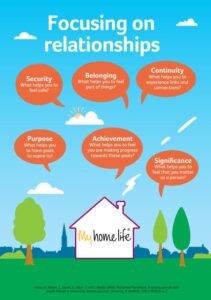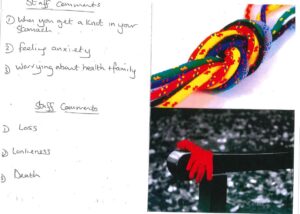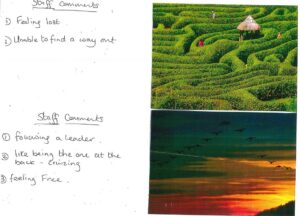Using My Home Life Picture Cards in team building session to explore perspectives
Picture Cards are one of the tools used on My Home Life England programmes to start conversations.
In this blog, David Unsworth, Charge Nurse at St Bartholomew’s Court, tells us how he recently used the cards from his programme in a session with care staff to promote team building, hear perspectives and connect emotionally.
Dave said:
“Prior to running the picture card session, I had spoken with a student nurse who I was mentoring. She was based on the South side within St Bartholomew’s Court, completing her Leadership and Management placement. She showed particular interest in the different approaches to leadership, taking special consideration of how these approaches work when in charge of the unit.
It was during this conversation that I mentioned that I had completed a My Home Life England leadership support programme.
I felt the programme had played a significant role regarding my own approach to leadership, whilst supporting employees and making them feel valued, in turn optimising patient care. I believe that demonstrating this approach on a day-to-day basis makes for a more positive workplace overall.
I decided to run a picture card session, to develop best practice together and focus on therapeutic staff relationships, thus creating an action centered learning environment and having caring conversations.”
Context
“The past week had been a very difficult time within our workplace. This was due to death of a long term resident, and also due to care staff sickness – some staff had worked overtime, or worked with one member of the care staff down.
I thought it would be a good opportunity to deliver a session that would promote team building, allow everyone to hear the care staff’s perspectives and also connect emotionally and empathically with each other. Plus the session would show how this positive approach can improve the working environment, and support care staff by allowing them time to express them their experiences, feelings, thoughts, opinions and any ideas they have to improve their working environment. This also supports and encourages their physical and emotional well-being.
The student nurse was also able to observe how this leadership approach could be put in practice, and the benefits of creating a positive working environment.”
Approach
“I laid out 20 Picture Cards which I thought would encourage care staff to express their thoughts and feelings. I explained that there were no right or wrong answers and everyone should pick one or two cards, then explain the reason why they chose them.
At first everyone just looked and studied the cards. I picked the first card and stated what I felt the picture made me think of and the reason why it stood out from the others to me. This gave everybody an idea of how the session would run.
All the care staff were really engaged and gave their views on what the cards meant to them. The cards opened conversations and enabled people to talk about their feelings, opinions, and their emotions that they had been experiencing over the past week.”
Following the session, the main outcomes were:
- “We recognized that, due to the service demand of residents, the way in which their needs were attended to was unevenly balanced. As a result of this imbalance, it was identified that there was scope to change the group dynamics. This ensured that, whilst still meeting people’s needs and ensuring optimal care, staff workload was evenly distributed and staff felt less strained.
- We identified that more support is required for all team members when dealing with bereavement following the death of a resident. Some care staff felt that it was not only them that felt the loss, but everyone within the work setting, i.e., Domestic, maintenance, kitchen and admin staff, also required support following the death of a resident.
- Some care staff were having difficulties in their personal lives and were made aware that they could be offered support with their mental health and wellbeing and with finances.
- We also identified that senior members of staff should reflect on how they approach prior to communicating with care staff.”
Conclusion
“I felt that the session had a very positive outcome with regards to creating a positive working environment.
It was very empowering for care staff – it had a focus of well-being and self-esteem, thus improving the therapeutic relationship amongst all members of the care team. Plus, of course, following the session, working practices were changed, thus letting care staff know that they had been listened to. It also gave the student nurse another leadership technique to utilise in her future career.
I realise how much the care staff enjoyed taking part because they were chatting among themselves on their lunch break, and they also discussed the session with the care staff on the North side of the home. Also, the Day Care Centre staff approached me and asked if they could utilise the picture cards for the residents who attend Day Care, as this would help them to express their thoughts and feelings and improve their therapeutic relationship with the attendees of Day Care.”
Dave Unsworth, said: 
“I really enjoyed the My Home Life England programme that I attended. It made me look at myself and my management and leadership skills.
There are so many areas of the training that made me self-assess my approach towards leadership, but the part that I utilise is the ‘Focusing on Relationships’.
As stated during the training “the My Home Life vision recognizes the importance of a positive relationship between older people, relatives and staff, as well as between care homes. To achieve good relationships and quality of life in this context, it is suggested that we need to consider what gives everyone a sense of security, belonging, continuity, purpose, achievement and significance.”
Though utilising these stages, I have built better relationships with the staff within my setting, hence the reason I initiated the team building session with the picture cards.”



